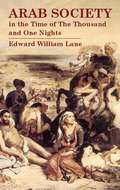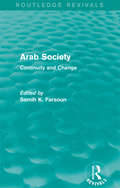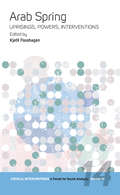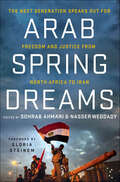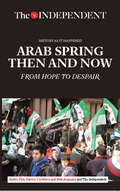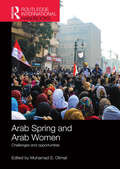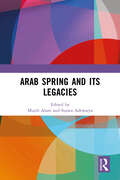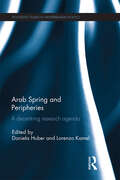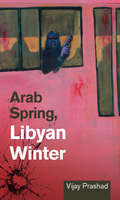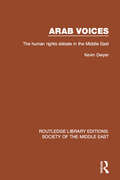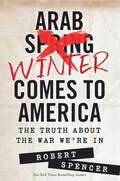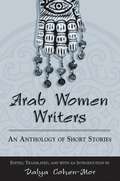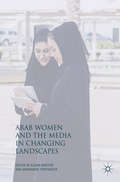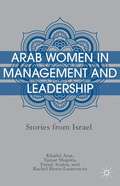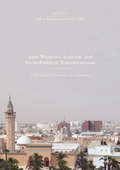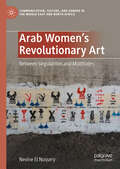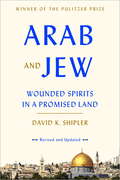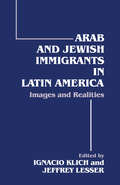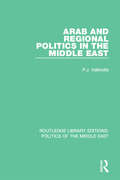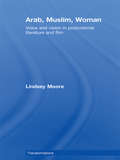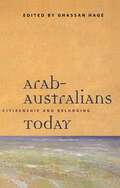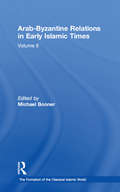- Table View
- List View
Arab Society in the Time of The Thousand and One Nights
by Edward William LaneElaborate, explanatory notes from the author's 1859 translation of the Arabian Nights comprise a virtual encyclopedia of Middle Eastern life. Intriguing account of Islamic society as it existed during the Middle Ages considers importance of religion, literature, festivals, education, slavery, role of women in society, and rituals observed for the dead.
Arab Society: Continuity and Change (Routledge Revivals)
by Samih K. FarsounThe Arab world has long been subjected to super-power rivalry for influence and control. The area has been characterized by bloody conflict with Israel and the internal instability that has been particularly prevalent in the last few years. Whilst these political struggles have been highly visible and at times spectacular over the decades, other transformations have taken place within the societies and peoples of the region, on a less pronounced – although just as profound – scale. The integration of the region into the world economy and the spread of Islamic revivalism are perhaps the most significant of these transformations. This volume, inspired by a lecture series on the Arab world in transition at the American University, Washington D.C., was first published in 1985. It discusses a wide range of issues, from economic to religious, which together form an in-depth analysis of the complex processes of transformation in Arab society. This is a fascinating work that holds the same interest and value to scholars and students of Middle Eastern history, politics and domestic affairs, as it did when it was first published.
Arab Spring
by Kjetil FosshagenThe events of the Arab Spring presented a dramatic reconstitution of politics and the public sphere through their aesthetic and performative uses of public space. Mass demonstrations have become a new global political form, grounded in the localization of globalizing processes, institutions, and relationships. This volume delves beneath the seemingly chaotic nature of events to explore the structural dynamics underpinning popular resistance and their support or suppression. It moves beyond what has usually been defined as Arab Spring nations to include critical views on Bahrain, the Palestinian territories, and Turkey. The research and analysis presented explores not just the immediate protests, but also the historical realization, appropriation, and even institutionalization of these critical voices, as well as the role of international criminal law and legal exceptionalism in authorizing humanitarian interventions. Above all, it questions whether the revolutions have since been hijacked and the broad popular uprisings already overrun, suppressed, or usurped by the upper classes.
Arab Spring Dreams: The Next Generation Speaks Out for Freedom and Justice from North Africa to Iran
by Nasser Weddady and Sohrab AhmariFrom a gay man secretly mourning his lover's suicide in Morocco to a young woman denied schooling because of religious discrimination in Iran, Arab Spring Dreams spotlights some of the Middle East's most outspoken young dissidents. The essayists cover a wide range of experiences, including premarital sex, the lack of educational opportunities, teenage marriage, and the fight for political freedom. They also highlight how repressive laws and cultural mores snuff out liberty and stifle growth and consider how previous movements - particularly the American civil rights struggle - might be channeled to effect change in their own countries. Beautifully written and profoundly moving, these stories present a decisive call for change at a crucial point in the evolution of the Middle East.
Arab Spring Then and Now: From Hope to Despair (History as it Happened)
by Robert Fisk Patrick Cockburn Kim Sengupta The IndependentThree award-winning journalists dive into the 2010 uprising that engulfed North Africa and the Middle East—and its aftermath.&“The big problem with the Middle East is to get people to see it from a different perspective; to stop accepting the American version of reality, i.e. &‘terror terror terror,&’ and instead look at the question of injustice. Seeing a different perspective, that of people who suffer for example.&”—Robert Fisk, The Independent In December 2010, the &“Tunisian Revolution&” touched off a wave of protests, riots, revolutions and civil wars throughout the Middle East. Initially the world hoped for positive change—democracy, free elections, and human rights. But, by 2012 the Arab Spring had morphed into &“Arab Winter&” bringing death, destruction, and despair. The Independent&’s Robert Fisk, Patrick Cockburn, and Kim Sengupta, among the most acclaimed Middle East correspondents of our generation, examine the events of this regional tsunami that threatens to have an impact on our world for years to come.
Arab Spring and Arab Women
by Muhamad S. OlimatThis volume examines the role of Arab women in Arab Spring and their contribution to the ongoing process of change sweeping the region. The book begins with an examination of the process of democratization and its impediments in the Arab World since the Second World War. It then looks at the conditions that led to the upsurge of the so-called Arab Spring. Finally, it underscores women’s role as participants, organizers, leaders, but also as victims. The main thesis of the book is that while Arab women were an integral part of the revolutionary efforts within the Arab Spring paradigm, they did not benefit from their sacrifices. Although they continue to be part of the process of change, their gains, rights and scope for participation are still limited. If the expansion of women’s participation and the scope of their rights do not seem to be a priority for revolutionary forces, women have made remarkable achievements, especially in some Arab Spring countries such as Yemen and Libya. The book includes case studies of some Arab Spring countries and other countries influenced by developments: Egypt, Bahrain, Kuwait, Libya, Yemen, Algeria, Jordan, Morocco and Saudi Arabia. It calls on revolutionary and reformist forces to give special attention to issues related to Arab women, as they are an indispensable pillar in the process of reform, development, peace and stability in the Middle East.
Arab Spring and Its Legacies
by Sujata Ashwarya Mujib AlamThe essays in this edited volume seek to understand the regional and international ramifications of the wave of protest demonstrations that swept across West Asia and North Africa in the early 2010s, both on the ground and online. Dissatisfaction with political repression and corruption, economic difficulties and inequities, and a desire for freedom and democracy all played a role in the Arab Spring uprisings. It deposed long-standing dictatorships, ushering in a period of insecurity and instability that would have long-term consequences for the region's political economy and international relations. Although the protests have ended, the legacy of that turbulent era will live on, most notably in the acceleration of regional change and transformation.Print edition not for sale in South Asia (India, Sri Lanka, Nepal, Bangladesh, Pakistan and Bhutan)
Arab Spring and Peripheries: A Decentring Research Agenda (Routledge Studies in Mediterranean Politics)
by Daniela Huber and Lorenzo KamelThe emerging literature on the so-called ‘Arab Spring’ has largely focused on the evolution of the uprisings in cities and power centres. In order to reach a more diversified and inner understanding of the ‘Arab Spring’, this edited book examines how peripheries have reacted and contributed to the historical dynamics at work in the Middle East and North Africa. It rejects the idea that the ‘Arab Spring’ is a unitary process and shows that it consists of diverse Springs which differed in terms of opportunity structure, strategies of a variance of actors, and outcomes. This book looks at geographical, religious, gender and ethnical peripheries, conceptualizing periphery as a dynamic structure which can expand and contract. It shows that the seeds for changing the face of politics and polities are within peripheries themselves. Focusing on the voices of peripheries can therefore be a powerful tool to ‘de-simplify’ the reading of the Arab Spring and to reshape the paradigmatic schemes through which to look at this part of the world.This book was published as a special issue of Mediterranean Politics.
Arab Spring, Libyan Winter
by Vijay PrashadThe Arab Spring captivated the planet. Mass action overthrew Tunisia's Ben Ali and Egypt's Hosni Mubarak. The revolutionary wave spread to the far corners of the Arab world, from Morocco to Bahrain. It seemed as if all the authoritarian states would finally be freed, even those of the Arabian Peninsula. People's power had produced this wave, and continued to ride it out. In Libya, though, the new world order had different ideas. Social forces opposed to Muammar Qaddafi had begun to rebel, but they were weak. In came the French and the United States, with promises of glory. A deal followed with the Saudis, who then sent in their own forces to cut down the Bahraini revolution, and NATO began its assault, ushering in a Libyan Winter that cast its shadow over the Arab Spring. This brief, timely analysis situates the assault on Libya in the context of the winds of revolt that swept through the Middle East in the Spring of 2011. Vijay Prashad explores the recent history of the Qaddafi regime, the social forces who opposed him, and the role of the United Nations, NATO, and the rest of the world's superpowers in the bloody civil war that ensued. Vijay Prashad is the George and Martha Kellner Chair of South Asian History, and professor and director of international studies at Trinity College in Hartford, Connecticut. He is the author or editor of over a dozen books, including Karma of Brown Folk and, most recently, The Darker Nations: A People's History of the Third World.
Arab Spring: Modernity, Identity and Change (Critical Political Theory and Radical Practice)
by Eid Mohamed Dalia FahmyThis book provides systematic, integrated analyses of emergent social and cultural dynamics in the wake of the so-called Arab Spring, and looks closely at the narratives and experiences of a people as they confront crisis during a critical moment of transition. Providing an interdisciplinary approach to interconnections across regional and communal boundaries, this volume situates itself at the intersection of political science, cultural studies, media and film studies, and Middle Eastern studies, while offering some key critical revisions to dominant approaches in social and political theory. Through the unique contributions of each of its authors, this book will offer a much-needed addition to the study of Middle East politics and the Arab Spring. Moreover, although its specific focus is on the Arab context, its analysis will be of issues of significant relevance to a changing world order.
Arab Voices: The human rights debate in the Middle East (Routledge Library Editions: Society of the Middle East #4)
by Kevin DwyerThis book, first published in 1991, moves beyond sensational headlines to explore how Middle Eastern men and women speak and feel about the societies in which they live. Kevin Dwyer makes use of extensive research and interview material from Egypt, Tunisia and Morocco and combines first-hand testimony with vivid and illuminating analysis. The voices are those of lawyers, political militants, religious thinkers, journalists and human rights activists who focus their discussion on the question of human rights and critical issues in social and cultural life.
Arab Water Security
by Hussein A. AmeryThis book explores the national security implications of the Arab Gulf states' reliance on desalination plants, and their related infrastructure. It provides the first systematic and comprehensive discussion of current and future threats to the supply of freshwater from a desalination plant, including actual and virtual attacks by terrorists, mechanical failure, contamination, sabotage by aggrieved workers, attacks relating to regional conflicts, as well as their vulnerability to natural disasters. It also provides a detailed analysis of the effects of a potential disruption to the water supply, and proposes possible measures, both political and technological, that can be used to increase resilience to these threats. Arab Water Security is a valuable reference for researchers and graduate students, as well as for policy makers and professionals, interested in water security, natural resources, and environmental terrorism.
Arab Winter Comes to America: The Truth About the War We're In
by Robert SpencerOverlooked by our media, purposely obscured by our own government, and unnoticed by the vast majority of Americans, the turmoil of the Islamic world's "Arab Spring" has become an "Arab Winter," bringing new threats of terror to America. New York Times bestselling author Robert Spencer, an expert on Islam and terrorism, reveals why America is shockingly unequipped to face this threat. In Arab Winter Comes to America: The Truth about the War We're In, you'll learn why the Obama administration has opted to appease rather than confront Islamic extremists in the United States; how Muslim organizations are pressuring witnesses to terror crimes not to cooperate with authorities; why the Justice Department has buried select news stories; and much, much more.The "Arab Spring" uncorked a jihadist genie in North Africa and the Middle East. It is about to wreak its mayhem here, with renewed terrorism. Americans need to inform themselves of the threat-and ensure that their elected government in Washington takes action. Robert Spencer's Arab Winter Comes to America sounds the alarm and shows what needs to be done. It is essential reading.
Arab Women Writers: An Anthology of Short Stories (SUNY series, Women Writers in Translation)
by Dalya Cohen-MorConsisting of sixty short stories by forty women writers from across the Arab world, this collection opens numerous windows onto Arab culture and society and offers keen insights into what Arab women feel and think. The stories deal not only with feminist issues but also with topics of a social, cultural, and political nature. Different styles and modes of writing are represented, along with a diversity of techniques and creative approaches, and the authors present many points of view and various ways of solving problems and confronting situations in everyday life. Lively, outspoken, and provocative, these stories are essential reading for anyone interested in the Arab world.
Arab Women and the Media in Changing Landscapes
by Elena Maestri Annemarie ProfanterThis volume explores the dialogue between Arab media and global developments in the information age, looking at the influence of new technologies in Arab societies and the evolving role of Arab women in 'old' and 'new' media. By gathering together contributions from both Arab and non-Arab scholars alike, a timely and important collection is presented that sheds new light on the growing involvement, role and image of Arab women in the media.
Arab Women in Management and Leadership
by Khalid ArarAn exploration of the life-stories of 22 pioneer Arab women who have forged their path to management and leadership in education and welfare, overcoming challenges imposed by a patriarchal society that sees female leadership as a threat.
Arab Women's Activism and Socio-Political Transformation: Unfinished Gendered Revolutions
by Sahar Khamis Amel MiliThis book illustrates how Arab women have been engaging in three ongoing, parallel struggles, before, during, and after the Arab Spring, on three levels, namely: the political struggle to pave the road for democracy, freedom, and reform; the social struggle to achieve gender equality and fight all forms of injustice and discrimination against women; and the legal struggle to chart new laws which can safeguard both the political and the social gains. The contributors argue that while the political upheavals were oftentimes more prevalent and visible, they should not overshadow the parallel social and legal revolutions which are equally important, due to their long-term impacts on the region. The chapters shed light on the intersections, overlaps and divergences between these simultaneous, continuous gendered struggles and unpacks their complexities and multiple implications, locally, regionally, and internationally, across different countries and through different phases.
Arab Women's Revolutionary Art: Between Singularities and Multitudes (Communication, Culture, and Gender in the Middle East and North Africa)
by Nevine El NosseryThis book examines the ways in which women in the contemporary Middle East and North Africa have re-imagined revolutionary discourses through creativity and collective action as a means of resistance. Encompassing a stunning array of forms and genres, such as graffiti, street performance, photography, phototexts, novels, and comics, the book draws from a vast spectrum of artistic production in revolutionary periods between 2011 and 2022 in Egypt, Tunisia, Morocco, and Algeria. El Nossery sheds light on women’s postrevolutionary artistic output by engaging an interdisciplinary approach: the book is divided into three sections which foreground the unique relationship between textual, visual, and performative modes as they intertwine with art and politics. Arab Women’s Revolutionary Art thereby aims to demonstrate how art, as always oriented towards an open future, can preserve the revolutionary spirit that was sparked in 2011 by documenting what happened and determining which stories would be told. The revolution, therefore, continues.
Arab and Jew: Wounded Spirits in a Promised Land
by David K. ShiplerThe expanded and updated edition of David Shipler's book that examines the relationship, past and present, between Arabs and Jews<P><P> In this monumental work, extensively researched and more relevant than ever, David Shipler delves into the origins of the prejudices that exist between Jews and Arabs that have been intensified by war, terrorism, and nationalism.<P> Focusing on the diverse cultures that exist side by side in Israel and Israeli-controlled territories, Shipler examines the process of indoctrination that begins in schools; he discusses the far-ranging effects of socioeconomic differences, historical conflicts between Islam and Judaism, attitudes about the Holocaust, and much more. And he writes of the people: the Arab woman in love with a Jew, the retired Israeli military officer, the Palestinian guerrilla, the handsome actor whose father is Arab and whose mother is Jewish.<P> For Shipler, and for all who read this book, their stories and hundreds of others reflect not only the reality of "wounded spirits" but also a glimmer of hope for eventual coexistence in the Promised Land.<P> Pulitzer Prize winner
Arab and Jewish Immigrants in Latin America: Images and Realities
by Jeffrey Lesser Ignacio KlichThis collection of essays addresses various aspects of Arab and Jewish immigration and acculturation in Latin America. The volume examines how the Latin American elites who were keen to change their countries' ethnic mix felt threatened by the arrival of Arabs and Jews.
Arab and Regional Politics in the Middle East (Routledge Library Editions: Politics of the Middle East #1)
by P.J. VatikiotisThree main themes are explored in this book, first published in 1984: the first is the problem of religion and politics as a major and long-standing preoccupation of Middle-easterners or Arab Muslims themselves; the second is that of the conflict-ridden inter-Arab and regional politics, approached largely from a local rather than an international perspective; the third deals with Egypt. The book also enquires into the nature of rule and regimes in the Middle East, the basis of authority and the arrangements for the organisation, exercise and use of power. Drawing examples from Egypt and the Fertile Crescent, the emphasis is on the relation between tradition and politics, historical evolution and state policy, domestic factors and external constraints.
Arab, Muslim, Woman: Voice and Vision in Postcolonial Literature and Film (Transformations)
by Lindsey MooreGiven a long history of representation by others, what themes and techniques do Arab Muslim women writers, filmmakers and visual artists foreground in their presentation of postcolonial experience? Lindsey Moore’s groundbreaking book demonstrates ways in which women appropriate textual and visual modes of representation, often in cross-fertilizing ways, in challenges to Orientalist/colonialist, nationalist, Islamist, and ‘multicultural’ paradigms. She provides an accessible but theoretically-informed analysis by foregrounding tropes of vision, visibility and voice; post-nationalist melancholia and mother/daughter narratives; transformations of ‘homes and harems’; and border crossings in time, space, language, and media. In doing so, Moore moves beyond notions of speaking or looking ‘back’ to encompass a diverse feminist poetics and politics and to emphasize ethical forms of representation and reception. Aran, Muslim, Woman is distinctive in the eclectic body of work that it brings together. Discussing Algeria, Egypt, Jordan, Lebanon, Morocco, the Palestinian territories, and Tunisia, as well as postcolonial Europe, Moore argues for better integration of Arab Muslim contexts in the postcolonial canon. In a book for readers interested in women's studies, history, literature, and visual media, we encounter work by Assia Djebar, Mona Hatoum, Fatima Mernissi, Ahlam Mosteghanemi, Nawal el Saadawi, Leila Sebbar, Zineb Sedira, Ahdaf Soueif, Moufida Tlatli, Fadwa Tuqan, and many other women.
Arab-American Faces and Voices: The Origins of an Immigrant Community
by Elizabeth BoosahdaIn this book, Elizabeth Boosahda, a third-generation Arab American, draws on over two hundred personal interviews, as well as photographs and historical documents that are contemporaneous with the first generation of Arab Americans (Syrians, Lebanese, Palestinians), both Christians and Muslims, who immigrated to the Americas between 1880 and 1915, and their descendants.Boosahda focuses on the Arab-American community in Worcester, Massachusetts, a major northeastern center for Arab immigration, and Worcester's links to and similarities with Arab-American communities throughout North and South America.
Arab-Australians Today: Citizenship and Belonging
by Ghassan HageArab people first came to Australia in the late nineteenth century. Today more than half a million Australians claim some form of Arab ancestry.They are a diverse group, both socially and economically. New South Wales, for example, appointed Australia's first Lebanese Governor, while at the same time it was labelling groups of economically deprived young people as 'Lebanese gangs'. Victoria's Premier, Steve Bracks, comes from a Lebanese background. Melbourne has an important Arab business community, while newly arrived Arab immigrants have one of the highest rates of unemployment in the country.Arab-Australians Today raises important questions about immigration, settlement, marginalisation and participation in Western societies. It discusses the way early Arab immigrants were received in Australia and talks about contemporary issues of participation in the Australian political process. It examines the lives of diverse groups of people, ranging from entrepreneurs to Arab women activists to unemployed youth. It analyses issues ranging from the ways Arab-Australians grow to call Australia home, to the moral panic created around Arab youth and criminality.The book offers non-Arab-Australians a way to better understand the Arab presence in Australia. It is also an invitation for Arab-Australians to reflect on the history of their settlement in Australia, as well as on the current experience of more recent immigrants.
Arab-Byzantine Relations in Early Islamic Times (The Formation of the Classical Islamic World #8)
by Michael BonnerThe Byzantine Empire was the Islamic commonwealth’s first and most stubborn adversary. For many centuries it loomed large in Islamic diplomacy, military operations and commerce, as well as in Islamic representations of the world in general. Moreover, the ways in which early Muslims and Byzantines perceived one another ” both polemically and otherwise ” afterwards proved decisive for the mutual perceptions between the Islamic world and Christian Western Europe. For these and other reasons, Arab-Byzantine relations have been a major concern of modern scholarship on early Islam for well over a century. Arab-Byzantine Relations in Early Islamic Times presents some of the most important of these contributions, organized according to the following themes: war and diplomacy; frontiers and military organization; polemics and images of the 'other'; exchange, influence and convergence; and martyrdom, jihad and holy war. An introductory essay discusses these themes within the contexts of early Islamic society, politics and economy.
